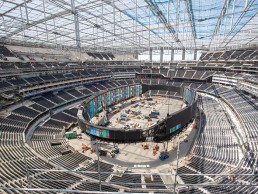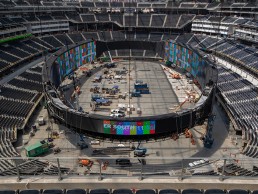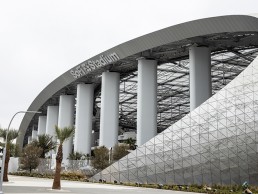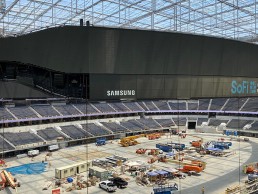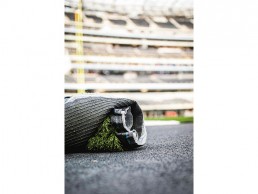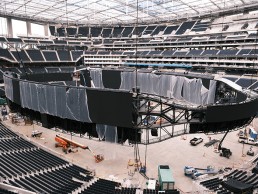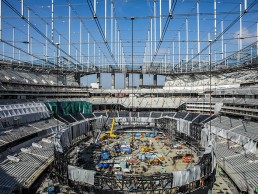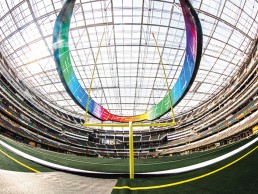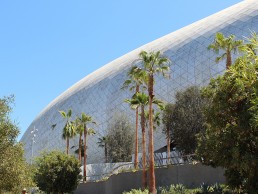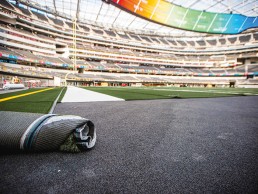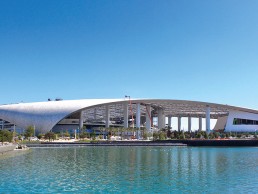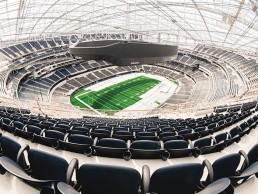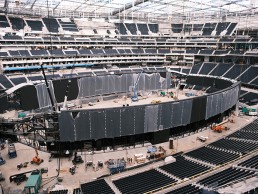This website uses cookies so that we can provide you with the best user experience possible. Cookie information is stored in your browser and performs functions such as recognising you when you return to our website and helping our team to understand which sections of the website you find most interesting and useful.
SoFi Stadium
ProjectSoFi StadiumLocationInglewood, CaliforniaManufacturers Samsung, JBL Professional, Cisco, Hella ConstructionArchitectHKS ArchitectsInstallerPro Media Audio Video Submitted by Samsung
SoFi Stadium, located inside the brand-new Hollywood Park in Inglewood, California, is the newest large-scale, stand-out stadium to be constructed in the US. The state-of-the-art home of the LA Rams and the LA Chargers, will be the largest indoor-outdoor stadium in the NFL at 3.1 million sq ft, and will be the centrepiece of the world-class sports and entertainment destination being built by Los Angeles Rams Owner and Chairman, E. Stanley Kroenke. The stadium will sit alongside a hotel, and premium retail and hospitality spaces, as well as commercial office areas and outdoor parks that aim to take the game day experience to new heights, offering fans a jam-packed day out featuring never seen before technology.
The stadium has been a huge boost for the economy and Inglewood’s community spirit, with a third of the 12,000 workers coming from Inglewood and the two surrounding zip codes. When the venue is fully open, it will also provide over 3,000 game day jobs across its various retail and hospitality spaces. As well as the help from local residents and businesses, SoFi Stadium collaborated with HKS Architects, Walter P Moore, Samsung, HARMAN and Pro Media Audio Video, to name but a few, to fully enhance the fan experience and firmly set it on the map as one of the best stadiums in the world.
Currently, SoFi Stadium is around 97% complete, and will soon open and play host to an array of exciting sports and entertainment events. Having already secured Super Bowl LVI in February 2022, as well as the College Football Championship Game in 2023, and the Opening and Closing Ceremonies of the Olympic Games in 2028, the venue is set to become one of the most hotly tipped sporting destinations across the globe. SoFi will have the ability to hold a seated capacity of approximately 70,000, which is then expandable up to 100,000 featuring 26 luxury suites and more than 13,000 premium seats.
Skarpi Hedinsson, Chief Technology Officer at SoFi Stadium takes up the story: “It’s been over 100 years since a stadium of this size and scale has been built in Los Angeles, so SoFi and Mr Kroenke’s vision has the ability to completely reinvent the city. I think the stadium will provide an unrivalled experience that really shows the fans how an event should be experienced, whether it’s an NFL game or a live concert.
“Across sport, especially in the US, we’re seeing new venues built that want to have an element of premium. I’m not talking about just the premium suites here, but premium across the board, including more food and drink offerings, better facilities, outstanding technology and better presentation across the stadium as a whole. With SoFi we worked hard to come up with ways to really provide a unique game-day experience that incorporated all elements of technology and matchless offerings.”
Heading up the design of the stadium was HKS Architects, an architectural firm with real grounding in sporting venues, with the company also being behind the Dallas Cowboys’ $1.3 billion retractable roof at AT&T Stadium in Arlington, Texas, and the Minnesota Vikings’ fully enclosed $1 billion U.S. Bank Stadium in Minneapolis.
During the design process the team at HKS considered a number of factors including industry, architecture, lifestyle, climate, geography and landscape to create an authentic Southern Californian expression and experience at SoFi stadium. “The sweeping Southern Californian coastline and the beauty and strength of the ocean contribute to the clean and dramatic curves of the stadium’s unmistakable architecture,” explained Lance Evans, Senior Designer, HKS Architects. “We created a venue that epitomises the SoCal indoor-outdoor lifestyle. The stadium’s roof, seating bowl, concourses, and landscape were all sculpted and designed to create the feel of an outdoor venue, while providing all of the flexibility of a traditional domed stadium.”
HKS were tasked with matching the architecture of the building to the unrivalled fan experience that will take place within the walls. To help enhance this, a series of unique seating products with the ability to cater to a wide range of fan preferences, including large suites and patio clubs that feature unique park-like landscape environments and unparalleled views were installed. “As well as the seating, we designed the stadium environment into a meandering, ultra-premium, 360º experience to give fans the opportunity to discover new and exciting offerings, game to game,” said Mark Williams, Principal at HKS Architects. “In order to take full advantage of LA’s incredible climate, views and landscape, we had to reimagine how concourses flow and function. In a typical stadium the field is the singular attraction, so we naturally focus everyone on that. But with SoFi Stadium, there are multiple attractions – the field, the huge centre-hung Samsung videoboard, the breath-taking views in all directions around the site, and the diverse landscape of each entry – and we wanted fans to be able to enjoy these from anywhere in the stadium.
“We designed the concourses to be as open as possible with views both in and out of the stadium. For example, walking around the upper concourse there are uninterrupted views down to the field, an epic wide-screen view of the video board, and full 360º views of the Southern California site, all while providing ample concessions, bars, restrooms, service and circulation space.”
As SoFi Stadium will also be a destination for entertainment and large-scale concerts alongside sport, HKS Architects had to take this into consideration during the design process, in order for the stadium successfully play host to such a diverse range of performers. “We design all of our projects to maximise both scalability and flexibility. At SoFi Stadium, the seating bowl is designed to host many different types of events with many different audience sizes, configurations and capacity requirements. Sports and entertainment venues are designed to accommodate a wide variety of bowl configurations, but most typically appear very temporary in design and experience. Our goal is that SoFi Stadium appears to be designed specifically for every unique event it hosts. We have planned for our design to meet the needs of events from the Olympics to local gatherings,” explained Mark.
Structural Engineers, Walter P Moore, worked on the structural and enclosure engineering at SoFi Stadium. With a long history of close collaboration with HKS Architects, especially on innovative designs in the sporting sector, Walter P Moore was present from the very early stages of SoFi Stadium’s design. “As Principal in Charge, one of my responsibilities was to handpick the subject matter experts capable of taking this design idea and driving it to the finish line where we are today. With so many details to pay attention to, we had to stay focussed on the bigger picture – achieving the overall vision for the project set by Los Angeles Rams Owner/Chairman E. Stanley Kroenke. We had a great collaborative and accountable team on the project,” explained Mashari Nassar, Senior Principal, Structures, Walter P Moore.
Bart Miller, Principal, Structures, furthered: “Walter P Moore specialises in the delivery of large, complex sports venues, and draws from our extensive portfolio of recent and relevant projects to ensure we’re leveraging the most current technologies and trends in the market. We work as a global team, leveraging firmwide expertise, and industry-recognised subject matter expertise to apply best design practices and lessons learned from the earliest stages of the design process. We’ve also developed design tools and planning and management processes that allow us to tackle these projects efficiently and with reduced risk to our clients.”
The team at Walter P Moore solved complex technical problems at the stadium with a graceful structural system that melded into HKS’ architectural vision. Early design charrettes were key in developing structural systems that supported Mr. Kroenke’s project vision, while considering numerous other factors such as structural efficiency and constructability. Mark Williams, Senior Principal, Diagnostics at Walter P Moore explained further: “There were five guiding principles: Firstly, structurally separate the roof from the bowl structure to allow each to respond independently under seismic forces; then, support the roof outside the excavation to limit column height and enable concurrent construction. We also had to ensure the venue provided for excellent seismic performance and used lightweight roof systems to reduce seismic mass. Most importantly, we had to support the design vision of Mr. Kroenke and not distract from it with an ungraceful structure.
“I think what really stands out is the way the design weaves together so many different program elements under a massive common roof. LA is the ideal place something like this could have been built; in almost any other climate we would be concerned with how we can enclose and condition the environment under a roof. It is much more than just a stadium under a roof, there is the performance venue, American Airlines Plaza, and various site structures. With the roof open around the perimeter, you are both inside and outside simultaneously. Even the deep excavation is leveraged in areas like the east and west canyons that take you down and into the stadium, which is a completely different experience than any other venue. It’s amazing, and there is so much engineering that went into making those things possible that the patrons will never see because it’s buried in massive heaps of very carefully designed earth.”
Focussing on SoFi Stadium’s ETFE roof, the design covers the entire playing field and everything surrounding it. An integral part of Mr Kroenke’s vision was the ability to connect the fans to the outside world, making fans feel like they’re outdoors, but with weather protection for event uncertainty. Walter P Moore utilised a single layer of transparent membranes of ETFE foil and subdivided each 60 ft x 60 ft cable net grid into a unique and separate tile of ETFE, supported on a lightweight steel frame. “This allowed us to assemble everything on the ground and then lift and set onto the top cables,”said Mark. “Around the roof edges, we made certain bays into smaller micro-operable panels that opened to ventilate the stadium below, which we could do at a scale of structure that wasn’t out of character with the rest of the roof. To our knowledge, it’s the first time micro-operable panels have been used on a stadium roof.”
When fans glance up, the uniquely shaped translucent canopy will project perforated abstract patterns that create an everchanging interplay of light and shadow throughout the stadium. Comprised of white anodised aluminium, the tonality of the panels change throughout the day – appearing almost pure white when in direct sun, and transition to capture the beautiful colours of the Southern California sky at sunrise and sunset. The perforated aluminium system also incorporates a network of colour-changing LEDs, which creates an incredibly vibrant venue that pulsates, reflects and reacts to the energy of any event. “It really brings the entire stadium to life!” exclaimed Lance.
Working hand in hand with HKS Architects and Walter P Moore was Henderson Engineers, who was brought in to serve as the engineer of record for the mechanical, electrical, plumbing, fire sprinkler, telecom, security, and audiovisual systems for everything except the interior of the seating bowl, and also serve as the acoustical consultant. The company also played a substantial role in the entitlement process and early planning phases. Given this is the largest sports project in history and located on a site with a long history and in close proximity to one of the busiest airports in the world, there were significant engineering challenges that needed to be navigated early in the project. While the design was extensive, so was the construction.
Kevin Lewis, Senior Vice President at Henderson Engineers, explained: “The project was a collaborative experience from the word go. Henderson played a significant role by making sure the building was constructed in accordance with the documentation. Given the quantity and quality of the premium spaces, it took significant coordination to make all systems work seamlessly with the architecture creating a one-of-a-kind fan experience.”
Because of the location of the site, both with regard to being in an active seismic zone and in the LAX flight path, the stadium is built in a man-made hole. Because of those factors, the stadium has a built-in system of mechanically stabilised earth using a vast array of supports and linkages. This required very specific modelling efforts to provide the appropriate number of telecommunications conduits into and out of the building, to support both telecom utility requirements, but also the private telecom infrastructure to support the unified vision of the entire development. The Henderson team was involved in the modelling process and coordinating different pathway options to avoid the mechanically stabilised earth structure, while still abiding by codes and standards related to number of bends in a telecommunications cable, pulling tension, and conduit capacity.
Some of the most unique elements of the stadium were worked on by Henderson Engineers, too, including the passively ventilated seating bowl, as Kevin explained further. “The location of the stadium allowed the design team to take advantage of the consistent climate, saving energy and creating a fan-friendly environment. While the stadium bowl has the ETFE roof canopy, it is not enclosed, and is considered an outdoor stadium. Henderson Engineers worked with HKS and RWDI to analyse the environmental conditions and architecture to create a bowl that takes advantage of natural winds helping to ventilate the stadium.”
The stadium’s ETFE roof will, no doubt, be one of the most impressive elements of SoFi Stadium’s design, but SoFi’s ingenuity doesn’t stop there. Attached to the unique roof structure will be the Oculus, Samsung’s 2.2-million-pound videoboard, covering 70,000 sq ft of digital LED. The board’s one-of-a-kind design and structure makes it the very first dual-sided centre-hung LED display, which will be used to elevate the fan experience to unparalleled heights. The state-of-the-art videoboard not only features the most LEDs ever used in a sports or entertainment venue, but also has the first and only 4K end-to-end video production in a stadium.
Brett Unzicker, Vice President, LEES, Display Division at Samsung Electronics America, worked closely on the videoboard at SoFi Stadium and was keen to explain more about the project. “The design process of the Oculus was very collaborative between Samsung and SoFi Stadium’s design team. We worked with architects and the stadium team to create a unique design that would set SoFi Stadium apart and bring to life Mr. Kroenke’s vision for a world-class sports and entertainment destination.
“Positioned 122 ft above the playing field and 70 ft below the roof canopy, the dual-sided videoboard has unprecedented viewing angles. Those sitting in the lower bowl will have a perfect view of the inner LED video board while those sitting in the upper bowl will enjoy an unobstructed view of the outer LED board. No matter where they are sitting in the stadium, fans will be in the centre of the action from kick-off to the final countdown.”
Skarpi furthered: “We wanted to create something that has never been built before. To an extent, the entire stadium was built around the videoboard and to have a piece of technology that hasn’t existed in this scale in sports before is incredibly exciting.”
Built for the future, the videoboard has the largest LED content playback system ever deployed. With nearly 80 million pixels spaced 8mm from centre to centre, each panel can be uniquely or congruently programmed with statistics, live and/or animated content. “We will have around 70-80 people dedicated to creating content for the Oculus on game day, so we will have an incredible capacity to create a stand-out show. It’s all about the fan experience, how do you engage them and provide a different experience, one that you wouldn’t find anywhere else,” explained Skarpi.
The largest panel is almost 40 ft or four stories tall, its smallest panel is nearly 20 ft or two stories tall. The unique size and shape of the Oculus make it wider than the field of play and offers fans a spectacular view from anywhere in the stadium, enhancing the action taking place on the field. The different sizes of the video panels are designed to serve spectators in every seat, from the sideline to the upper deck. Fans sitting in the lower bowl of the stadium will view the inside of the videoboard as it sits directly across from their line of view, while guests in the upper bowl will view the outer panels of the videoboard.
“Support of the videoboard was woven into the design of the roof and cable net. The framing of the video board is a modular oval structure and the steel was brought in shipping containers to an assembly yard. There it was placed into box trusses that were trucked to the site and simply stacked in a ring on the playing field. From there, the structure was assembled. By this point, the cable net was complete, and we hooked up strand jacks at the 14 hang points from the roof and lifted the videoboard structure about 25 ft off the ground. The video board hung in that position for several months while its cladding and electrical work were completed near the ground. A final lift brought the video board to its permanent elevation just below the bottom cable net, where permanent structural connections were made to a special set of cable clamps and, more or less, plugged it in,” explained Mark Williams of Walter P Moore.
“Like many industries, there has been a digital transformation when it comes to stadium technology,” explained Brett. “We want fans to feel the comforts of home at the stadium. In addition to the stunning videoboard and the five levels of fascia inside the bowl, fans can find display technology throughout SoFi Stadium and Hollywood Park, including in American Airlines Plaza and the performance venue, to ensure they don’t miss out on a minute of the on-field action.
“This is the beauty of our core product architecture. Outside of the main structure, nearly all of the systems use standard parts. In addition to the stadium, we are working on some technology that will be used at other sites throughout Hollywood Park, one of which being how to clean such a large screen with limited physical access.”
Built into the videoboard is a state-of-the-art JBL audio system with more than 260 of the stadium’s total 4,500 loudspeakers. The videoboard sound system accounts for half a million of the 1.3 million watts of Crown Audio amplification in the venue.
WJHW, providers of state-of-the-art design and consulting in audio, acoustics and noise control came up with the original sound system design for the stadium. The team incorporated part of the Samsung video display as a banner system used to house the audio.
“The videoboard was one of the biggest differentiators because of its size, shape and location” explained Saben Shawhan, Senior Manager for Audio Business Development and Support Teams at HARMAN. “It’s all in the same enclosure, which is a focal point of the design. So instead of putting loudspeakers wherever you wanted for coverage, everything has to live inside that video display enclosure. Everything has to be of a certain size, because you can’t exceed the height limit. That really drove the design. There are no options for how far away you are from the listener. There’s no changing it.”
As well as the JBL loudspeakers, the stadium uses Crown DCi N Series amplifiers for its amplification. “The Crown DCi N Series of amplifiers have some of the most sophisticated loudspeaker monitoring and reporting capabilities of any amplifier that I know of. They also have a proprietary limiting feature called LevelMAX. Because of where they’re located, replacing an amplifier or loudspeaker driver is not easy. So the system needs to be protected and monitored,” said Saben.
The audio supplied to SoFi Stadium is, again, about hightening the fan experience to never-achieved before levels. Saben explained: “Something that elevates that experience is this humongous wrap-around videoboard. And the same thing applies to the sound. It’s a huge component of what’s going on. Without audio, everything you see becomes a lot less meaningful. You have to tie the audio to the video, the game and the fan experience to make it more enjoyable and to draw people in. They want to feel like they’re part of something, and the JBL audio system does that.
“Also, there are some things that have to happen that maybe the patron isn’t thinking of, like intelligibility. It doesn’t help if the system is loud if you can’t understand what the announcer is saying. That’s an extremely important thing that can easily get overlooked or neglected because people are just focussed on making the system loud and not paying attention to those details.”
This cutting-edge technology within this 298-acre sports and entertainment destination in the heart of Los Angeles will set a new standard for the fan experience. SoFi Stadium and Hollywood Park could well represent the future of sports and live entertainment. “There’s a lot of synergy between the videoboard and the sound system. Using HARMAN Professional brands such as Samsung and JBL really gave us the capabilities to deliver clear audio into a stadium, which are usually notoriously difficult to amplify,” said Skarpi.
Another exciting technology partnership that SoFi Stadium entered was with Cisco. As the official IT network services partner of SoFi Stadium and Hollywood Park, the agreement includes an end-to-end deployment of Cisco’s industry-leading sports and entertainment solutions across SoFi Stadium and Hollywood Park to create one of the most innovative and technologically advanced mixed-use developments in the world.
Cisco’s intent-based networking technology will allow SoFi Stadium and Hollywood Park to streamline operations, facilitate IT and business innovation, and re-define what is possible for fans as part of the live event experience with new content, experiences and engagement opportunities.
The Cisco Connected Stadium Wi-Fi network at SoFi Stadium and Hollywood Park will utilise Wi-Fi 6, the next-generation wireless standard, and be the largest deployment ever of the technology in a sports venue. More than 2,500 Wi-Fi 6 access points in SoFi Stadium will deliver faster speeds for immersive-experience applications, more bandwidth (four times greater capacity than the previous Wi-Fi standard) and higher reliability, all while being less taxing on a device’s battery. The high-density network will also enable SoFi Stadium and Hollywood Park to leverage one secure Wi-Fi platform for employees, operations and fan-facing services.
“When our fans are at the stadium, they want to be connected. They want to upload content and share their experiences with friends and family, and that’s something that we really want them to do, too. Cisco have made this possible by implementing WiFi 6, it’s utilised the spectrum, which means we have more carrying capacity on our networks so we can deliver higher speeds and a better wireless experience for our guests in pretty substantial ways,” explained Skarpi.
The 298-acre global sports and entertainment destination will implement Cisco Vision, an end-to-end dynamic signage solution that combines high-definition video delivery with state-of-the art digital signage. The first-ever entirely 4K deployment of Cisco Vision will power approximately 2,500 screens throughout SoFi Stadium’s concourses, suites, concessions, as well as across Hollywood Park, making it one of the most sophisticated venues in the world to create and deliver media-centric experiences. With one central point of control for all screens, SoFi Stadium and Hollywood Park will have the ability to dynamically program every area of the property and take a customised approach for each screen as desired or needed.
This partnership with SoFi Stadium and Hollywood Park builds on Cisco’s longstanding expertise in the sports and entertainment industry. Over the past decade, Cisco has partnered with venues, teams, leagues and organisations to bring fans a more convenient and customised live experience. Cisco’s sports and entertainment solutions are now being used in hundreds of venues in numerous countries around the world.
Keeping with the state-of-the-art technology and important WiFi connectivity throughout SoFi Stadium, the impact of COVID-19 is, of course, looming on the minds of the stadium’s team, in terms of what can be achieved on upcoming match days taking part during the pandemic. The development of the SoFi Digital Connected App hopes to assist with any potential problems that may occur, as Skarpi explained: “There has been a trend for some time, I call it digital credentials, basically it’s being able to use your mobile device to do touchless transactions, as well as digital mobile ticketing and help with wayfinding around the stadium.”
The mobile app will provide fans with useful information regarding key areas of the stadium including parking, bars and restaurants, prices, and navigation around Hollywood Park itself, not just the stadium. “We wanted to provide our guests with a digital interface that helps them best understand what’s on offer, show upcoming events and activities, as well as keeping them safe and limiting the amount of contact between guests and staff. The app will be a sort of digital concierge that will be constantly evolving. We’ve developing it for quite some time, and we’re really look forward to presenting it soon,” said Skarpi.
Over the years, the hospitality opportunities provided inside global stadia have become much more sophisticated, providing fans with more than just a hot dog and pint of beer mid match. A full day of premium dining and drinking, with the retail experience to match, is now becoming widely accepted and expected from patrons. Of course, SoFi wanted to take this element of the stadium to the next level, too, so The Parker Company, specialists in hospitality procurement, was chosen to develop the hospitality opportunities inside the venue.
Tom Roche, Sales and Projects Director at The Parker Company takes up the story: “Originally, sports wasn’t actually something that we’d set out to do as a company, but around six years ago we realised that more stadiums are starting to look like five star hotels, with Michelin star restaurants and more premium hospitality offerings. People are willing to pay more to get more, especially with the club lounge concept, that’s really growing.
“Non match day experiences are now just as important as match day experiences. SoFi were looking for a very high-level of detail, so we were useful in terms of what they wanted for their stadium and the fit-out of it. We were also able to go into the project and actually save them money, we were able to provide a combination of a one-stop shop that could help them buy everything they needed, combined with a buying power that reduced their budget by an extremely large amount, and then the ability to actually deliver it.”
To solely focus and manage the project, The Parker Company opened up offices in LA. This allowed the team to work closely with the designers, engineers and architects to implement the best kind of hospitality services into SoFi. “Usually with a sporting venue, this is a once in a lifetime experience, so the client is starting from scratch without any background or knowledge about who provides the best catering service, or the most efficient WiFi system for example. The fact that we can bring 10,000 plus suppliers to the table, through one system to one point of contact is obviously hugely valuable and it saves both the client and the client team the effort of having to source all of this themselves. We can bring the world to them, essentially, so the initial crossover is knowledge,” explained Tom.
The Parker Company worked closely with the client representative, Legends, who specified the stadium’s requirements. The team then worked with individuals involved with the architecture, all the way through to the merchandising store and the museum to choose the best solutions for each individual corner of the stadium. “The beauty in the way we work is that we can tell our client what they can buy across the US, but also across Europe and Asia, too, which gives them the full picture of what they can achieve. After that, we sit back down with the design team and guide them through the final decision-making process. It is our job to capture everything in our system that will be required for the project,” concluded Tom.
Another key element of every sporting stadium is high-quality turf that has the ability to protect players and allow them to play the best game possible. Hellas Construction, a Texas based turfing company that installs athletic surfaces across a wide range of sporting applications, aided on the project. “A big part of when we were selecting the products for SoFi was player safety and performance. After that, we were concentrating on the durability and the multi-use, as the stadium will hold many events, not just sport,” explained James Towsley, Vice President at Hellas Construction.
Installed in SoFi Stadium is a very durable artificial turf, which is resilient to covering and uncovering for match-day and non-match-day events. The carpet is manufactured in Dalton, Georgia and it comes in rolls that are 15 ft from side-line to side-line. During the installation, the turf was laid out in five-yard increments across the playing field, a 10mm Cushdrain pad was firstly put down, this is a monolithically poured rubber surface that goes underneath the artificial turf, helping with player safety and to improve the field’s drainage. Then after that, the Hellas Construction team installed all of the turf, which is glued to cut in all of the short load extensions, the hash marks and any inlays that are not a complete length of a panel from side-line to side-line.
“This was such a great project to work on and hats off to the whole supply team, project managers, general contractors and everybody who worked on the project,” furthered James. “The sheer size of SoFi Stadium is very impressive, it’s such a unique venue. There’s a botanical garden with all kinds of native plant life and it’s also technically an outdoor stadium, but has a great indoor feel. It feels like your sat outside in a beautiful nature setting, but you’re really inside this incredibly awesome world of sports.”
Mark of HKS furthered: “SoFi Stadium couldn’t just be in Los Angeles, it had to be Los Angeles. With over 12 different club spaces and seven suite experiences, SoFi Stadium has all the optionality a sports fan could dream of. With each space being designed to cater to the different types users, a fan could find themselves anywhere from enjoying a cocktail with panoramic views of downtown to hanging out in an immersive experience right behind the players. Just like the architecture, you can’t turn a corner without discovering something new but familiar.”
SoFi Stadium looks set to be one of the most impressive sporting destinations across the world. With the implementation of never seen before state-of-the-art Samsung technology, ingenious architecture and the backdrop of the SoCal sunshine, fans can expect not just an NFL game, but one that combines all elements of indulgent entertainment, that aims to put fans at the very centre of the action. As the crown-jewel of the brand-new Hollywood Park complex, fans with also leave feeling like royalty.
